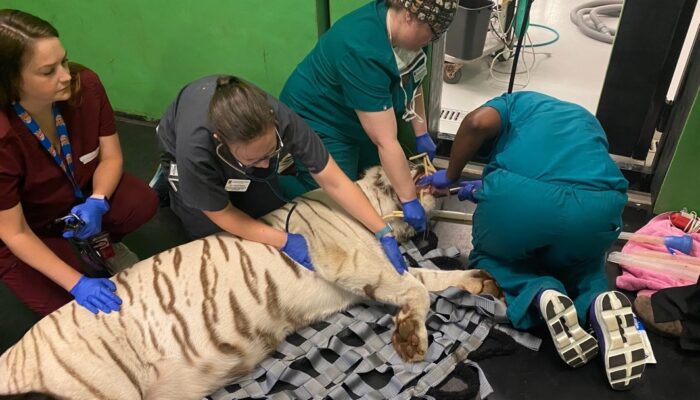Staff are no strangers to exotic patients
Pictured above: Athena in a pool, courtesy of Wild Animal Safari
It’s not every day that the clinical staff at the UGA Veterinary Hospital evaluates and even operates on a tiger, but “once in a blue moon there is a problem in those cats and we’re here to help,” said Dr. Joerg Mayer, professor of zoological medicine at the VTH in Athens.
As fate would have it, in the days leading up to the appearance of an actual blue moon,

VTH team tending to Athena, courtesy Dr. Joerg Mayer, UGA
Athena, an 8-year-old Bengal tiger who lives at the Wild Animal Safari zoo in Pine Mountain, came to visit while Mayer was on clinical duty. Athena was suffering with a suspected case of pyometra, a life-threatening infection of the uterus.
“The main concern of caretakers was that the animal was anorexic, sluggish,” Mayer said. “I think they noticed a whitish coloration of the urine, combined with fact she is female, sluggish, they suspected Pyometra, puss in the uterus. With intact animals that haven’t been spayed that can be a common presentation. All the clinical signs seemed to make sense, but then with hands on, ultrasound, turns out that wasn’t the case at all.”
Athena was diagnosed with cystic ovaries and spayed to prevent complications like pyometra in the future. She returned home healthy.
“The team at UGA did an incredible job working with Athena as they always do with our big cats,” said Katie Harrison, zoo director at Wild Animal Safari. “We appreciate all the care they put into evaluating and treating our animals.”
Like their smaller cousins, big cats (Mayer refers to them as “kitties”), are predisposed to certain diseases. They can also present with illnesses triggered by trauma, ingestion of foreign bodies or toxic plants, or metabolic problems. A skillful examination is key to making an accurate diagnosis, but sick or not, few big cats react well to a clinician climbing in their cage to conduct a thorough physical.
“With a dog or a cat, you can put them up on the table, pet them a little, put them at ease,” Mayer said. “With big cats it’s different. They may appear sluggish, but it can escalate quickly.”
Large animals must be sedated for examination, but the choice of drug is crucial in a case of unknown illness. Is it kidneys, liver, or cardiac trouble that’s making them ill? Sedation can mask and even exacerbate those conditions, making it more difficult for clinicians to diagnose and treat the problem.
And big cats that have lived in captivity for a while know the score when a white lab coat appears with a syringe on the end of a long pole. “They’re like, ‘Oh, the next thing they want me to do is to be a little bit tired,’ and then they act like they’re asleep and you go in and suddenly they’re like, ‘Tada! Kidding!” Mayer said.
The ears and nose are the most sensitive parts of an animal’s body, and they can’t fake a reaction when tickled there. So once the medical team has performed the tickle test and confirmed the animal is truly sleeping, they commence with their work.
While companion animals such as dogs and cats account for the lion’s share of clinic visits and emergency cases at the Veterinary Teaching Hospital, wildlife, reptiles, and exotic breeds make a sound showing as well. For example, in Fiscal Year 2023 the hospital treated:
- 2 Dromedary camels
- 2 bobcats
- 1 American bullfrog
- 4 Bald eagles
- 2 black vultures
- 2 American black bears
- 28 deer
- 22 chipmunks
- 49 Guinea pigs
- 1 Japanese koi
- 3 goldfish
